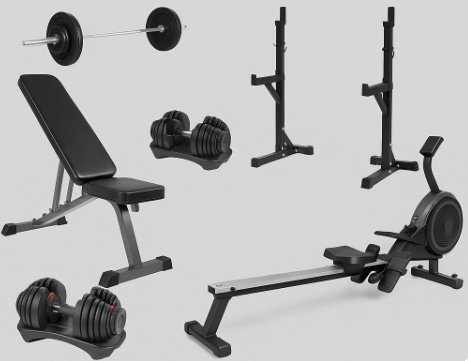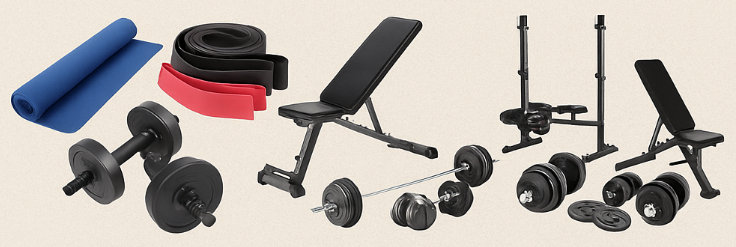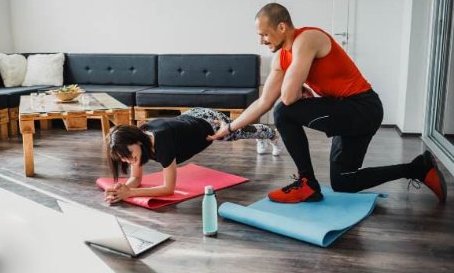Would you like to train at home without spending a fortune? Setting up a home gym is easier (and cheaper) than you think. In this guide, I’ll show you how to build your own home gym on a budget without sacrificing a complete and effective workout.
✅ Perfect for beginners, people with limited space, or those who want to save on monthly commercial gym fees.
1. What should you consider before setting up your home gym?
- Available space: It could be a room, garage, balcony…
- Your training goal: Do you want to build strength, do cardio, tone up…?
- How often you'll use the equipment
- Total available budget
Expert opinion: You don’t need to spend a fortune on gear to get fit, gain strength or muscle, and build a solid physique. I’ve got 15 years of experience in weight training, and let me tell you a secret the big gym chains don’t want you to know: muscle building is all about repetition, not innovation. That means you don’t need fancy equipment or modern machines. The basic exercises that worked 15–30 years ago still work today.
Also, you don’t need to set up a full-blown professional gym from day one. You can start small and gradually add equipment as needed.

2. Basic Equipment for a Budget Home Gym
Option 1: Ultra low budget (under €200)
You can start with the following for general fitness:
- Exercise mat
- Set of resistance bands
- Adjustable dumbbells or a kettlebell
- Ab wheel or core sliders
- Foldable budget bench (optional)
Option 2: Medium budget (€200–600)
For a more complete strength training setup, consider:
- Adjustable weight bench
- Barbell + weight plates
- Adjustable dumbbells
- Squat rack or small rack (make sure it includes safety catches—worth the extra cost to avoid injuries)
- Stationary bike or rowing machine
Tip: Look for second-hand or refurbished gear.
Option 3: Medium-high budget (€600–1200)
- Budget-friendly multi-gym machine
- Compact power rack
- Professional bench
- Full weight set (barbell, plates, dumbbells)
- Foldable treadmill or elliptical trainer (more durable, pro-grade cardio gear)

3. Where to Buy Affordable Home Gym Equipment
- Specialized store:
- Second-hand platforms: Wallapop, Milanuncios
- Outlet stores and refurbished equipment sellers
- Direct-from-manufacturer options (careful—many are overseas with unknown quality)
Expert tip: Always make sure the equipment is durable and safe. Cheap can sometimes cost more in the long run. Avoid flimsy benches and plastic dumbbells. Brands like Body Solid offer solid semi-pro gear at great prices—we work with them ourselves.
4. Money-Saving Tips When Building Your Home Gym
- Compare prices from different retailers
- Buy in bundles. If you’re getting multiple items, contact the store to ask for a deal. A serious seller will have contact forms, email, or WhatsApp.
- Take advantage of seasonal discounts
- Use home-grade equipment—but make sure it’s not low quality. Durable, reasonably priced gear is out there. Remember: “you get what you pay for.”
5. Want a Weekly Routine Using Minimal Equipment?

Monday – Full Body Strength
- Bodyweight squats: 3 sets x 15–20 reps
- Push-ups: 3 sets x 10–15 reps
- Band rows: 3 sets x 15–20 reps
- Plank: 3 sets of 1–2 minutes
Also check out:
Wednesday – Cardio/HIIT
- Jumping jacks: 3 sets x 20 reps
- Burpees: 3 sets x 12–15 reps
- Mountain climbers: 3 sets x 15 reps
- Fast squats: 3 sets x 20 reps
Friday – Strength + Core
- Dumbbell deadlifts: 3 sets x 12 reps
- Chest press: 3 sets x 12 reps
- Bicep curls: 3 sets x 12 reps
- Ab wheel rollouts: 3 sets x 10 reps
6. Conclusion: Is It Worth It?
Setting up a home gym on a budget is totally possible. All it takes is planning, determination, and smart gear choices.
✅ Start with the basics and upgrade over time. Your body—and your wallet—will thank you!
Looking for affordable, quality equipment?
- Browse our full range of gym machines and weights
- Budget-friendly multi-gyms
- Compact cardio equipment for home
❓ Frequently Asked Questions
What’s the minimum equipment needed to train at home?
A mat, resistance bands, a pair of adjustable dumbbells, and a bar with some plates are enough to get started.
Where can I find affordable gym machines?
You can buy from stores like DeporTrainer, look for second-hand deals, or take advantage of clearance sales and refurbished equipment.
How much space do I need to set up a home gym?
With just 4 to 6 m², you can have a functional workout space. In my personal opinion, you don’t need a whole room just for the gym. Of course, the ideal is to have a garage or a spare room, but a corner in your living room or even your bedroom can work just fine. And don’t worry about aesthetics—modern home designs often incorporate training gear, treadmills, or exercise bikes as part of the decor. As long as you tidy things up after your workouts, your space can still look great. Worried about space? No problem! There are foldable wall racks and compact bikes that won’t get in your way.
Should I install a multi-gym or buy free weights if I’m a beginner?

Expert advice: my recommendation is to always, always go with free weights if you’re a beginner. Free weights (plates, dumbbells, bars...) are not only more effective for building strength and muscle, but also cheaper and more versatile. They let you do a wider variety of exercises, while a multi-gym restricts you to a few fixed movements. Plus, if stored well, free weights take up less space. I’m not saying there aren’t good multi-gyms out there for home setups, but it’s better to consider them later. Oh, and forget those cheap €200 machines that claim to do it all—they’re usually flimsy. It’s better to start with free weights.
Once you’ve mastered weight training and have the budget and space, you can look for a quality multi-gym to expand your setup. But remember: multi-gyms should never replace free weights! They are only meant to complement barbell and dumbbell exercises.
After helping hundreds of clients build their home gyms from scratch, I’ve noticed that the most important factor in getting fit is not budget—it’s consistency. Even with minimal equipment, you can get great results if you stick with it. Having fancy machines won’t help if you’re not using them. Start small, stay consistent, and level up over time!
Still unsure what equipment to buy? Message me with no obligation—I’ll help you pick the best gear for your space and budget.

![HOW TO BUILD A HOME GYM ON A BUDGET [2024 GUIDE]](/modules//smartblog/images/296-single-default.jpg)
![CÓMO MONTAR UN GIMNASIO EN CASA CON POCO PRESUPUESTO [GUÍA 2024]](/modules//smartblog/images/296-home-small.jpg)




